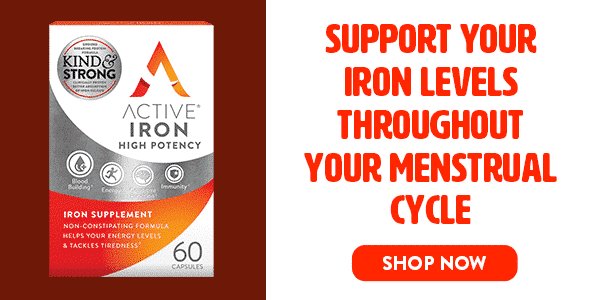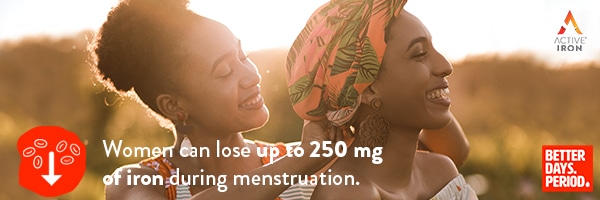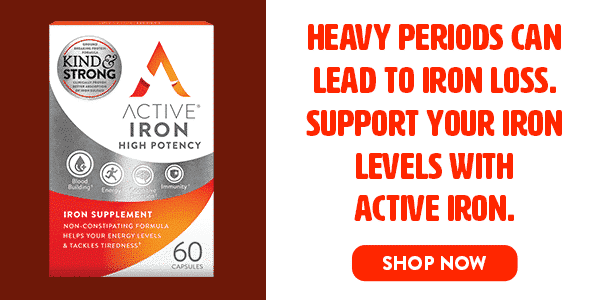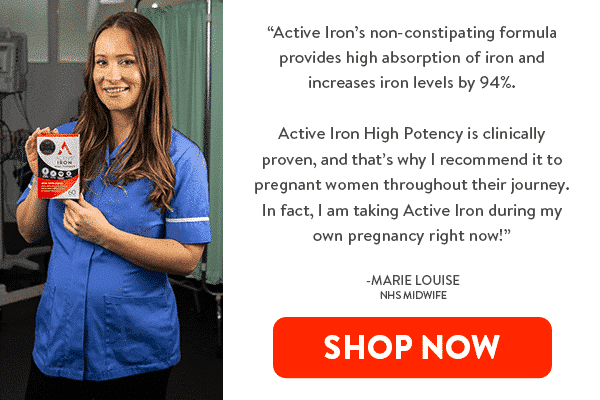While roughly half of the people in our world have, do, or will get them, periods are complex.
This guide will help you make sense of your reproductive system and menstrual cycle, where you can find answers to your questions regarding:
- Period symptoms
- Fatigue during your period
- Different types of periods
- Bloating during your period
- Back pain during your period
- Mood swings and irritation leading up to your period
- Cravings and food choices during your period
- Exercise during your period
- Period blood
- Postpartum periods
The Menstrual Cycle
The menstrual cycle is one of the most remarkable events within our bodies. It displays a fine-tuned interplay of hormones and physiological responses. Understanding our periods begins with understanding the menstrual cycle as a whole.
Our period gets all the attention because it’s the part of our menstrual cycles that is the most obvious and, for many, unpleasant. But, in reality, our periods are just one small part of an ongoing physical story. The less apparent events during your menstrual cycle dictate your period symptoms, timing, and even whether you get a period at all.

While the menstrual cycle is intricate, we can easily understand it by learning its two phases.
- The Follicular (or oestrogenic) Phase
The first part of the menstrual cycle begins on the first day of your period and lasts until you ovulate. As we’ll explain below, in the days leading up to your period, the uterine wall (or endometrium) has thickened to about 8-13 millimeters to provide the best conditions to nurture a fertilised egg. When pregnancy does not occur, the unfertilized egg and thickened uterine lining pass out of the body via the vagina.
From day 1 of your follicular phase, your body has already started to produce small but ever-increasing amounts of a hormone called Follicle Stimulating Hormone (FSH). This hormone causes around 15 to 20 eggs, each encased in their follicle, to mature in your two ovaries. These follicles produce the hormone Oestrogen, which is necessary for ovulation. When it’s time to ovulate, the egg from the largest and most dominant follicle will be released, and the remaining eggs will disintegrate.
The follicular phase’s duration can vary considerably from woman to woman and throughout a woman’s lifespan. On average, your Follicular Phase lasts about two weeks, but it can range anywhere from 8 to 21 days or longer to complete.
- The Luteal (or progestational) Phase
After ovulation, your body and hormones switch gears and enter the Luteal Phase. This second phase marks the length between ovulation and the last day before your period. Unlike Follicular Phases, Luteal Phases usually have a finite lifespan of about 12 to 16 days.
After one of your ovaries releases an egg, the follicle that held the egg collapses on itself, becoming what’s called the corpus luteum. The corpus luteum remains on the ovarian wall and releases the hormone progesterone.
Progesterone is a critical hormone in a woman’s menstrual cycle, and it leads the charge during the Luteal Phase. Among many things, it’s responsible for preventing the release of all other eggs during the rest of your cycle. Progesterone also causes the uterine lining (or endometrium) to thicken and sustain itself until the corpus luteum disintegrates about two weeks later.
If the released egg doesn’t become fertilised, progesterone (keeping the endometrial wall nourished and in place) plunges. This hormonal shift causes your period and day one of your next cycle.
Period blood
On the first day of your menstrual cycle and period, the endometrial wall begins to disintegrate. Over the next five or so days, the blood vessels that supply the endometrium with nutrients and oxygen begin to constrict, allowing the uterine lining to fall away. Blood and the collapsing endometrium move from the uterus through the cervix and out the vagina.
How much bleeding is typical during a period?
You may lose up to 16 teaspoons (or 80ml) of blood and other fluids throughout your period. The National Health Service says that 6 to 8 teaspoons of blood loss is typical. That’s about enough to fill about 6 to 8 pads or regular tampons.
According to the National Health Service, if you’re losing 80ml or more in each period, having periods that last longer than seven days, or both, you have heavy menstrual bleeding. Changing your sanitary products every hour or two, passing clots larger than 2.5cm, bleeding through your clothes or bedding, or using two types of sanitary products at once are all reasonable indications that your periods are heavy.
How long should bleeding continue?
According to the National Health Service, a period generally lasts between three to eight days. A period that lasts longer than eight days is considered prolonged menstrual bleeding. If you have abnormally heavy or prolonged bleeding routinely, it is recommended you consult your healthcare professional.
What blood colour is normal?
The Cleveland Clinic explains that healthy period blood typically ranges from bright red to dark brown or black. Orange or grey blood may be a sign of infection. Bright red blood is most likely present at the beginning of your cycle. Pink blood is at the beginning or end when your bleeding is at its lightest flow. Dark red, brown or black blood indicates slightly older blood and a slower flow as the blood darkens throughout your cycle.
What consistency is normal?
It’s normal for the consistency and colour of your blood to change throughout your period. According to the Cleveland Clinic, your menstrual blood may be thin and watery or thick and sticky. Blood clots during your period that are larger than one inch in diameter may be a sign of fibroids (non-cancerous growths in the uterine wall), miscarriage or an ectopic pregnancy. If you experience unusual bleeding or clotting, talk about these symptoms with your healthcare provider.
Types of periods
Menstrual cycles can vary drastically from woman to woman and even within a single woman’s lifetime. Below are the four types of periods.
Heavy Periods
Our research at Active Iron showed that 67% of the 2,400 women we surveyed experience heavy periods. According to the National Health Service, you may have heavy periods if:
- You have long periods that last eight days or longer
- Your period flow or length has recently increased significantly
- Your blood flow requires you to change your pad or tampon more than once an hour for six hours in a row or longer. Changing the pad in this way can be the symptom of abnormal bleeding (menorrhea) which is due to an abnormal underlying condition.
To determine what’s causing your heavy periods, your general practitioner may ask about:
- Your medical history
- How often do you have to change sanitary products
- How long do your periods usually last
- Any related symptoms, like pain or bleeding between periods
- How these symptoms affect your day-to-day life
Over the years, your period can change. Talk with your doctor if your periods become heavier. They can help determine the cause and offer insight into what steps help.
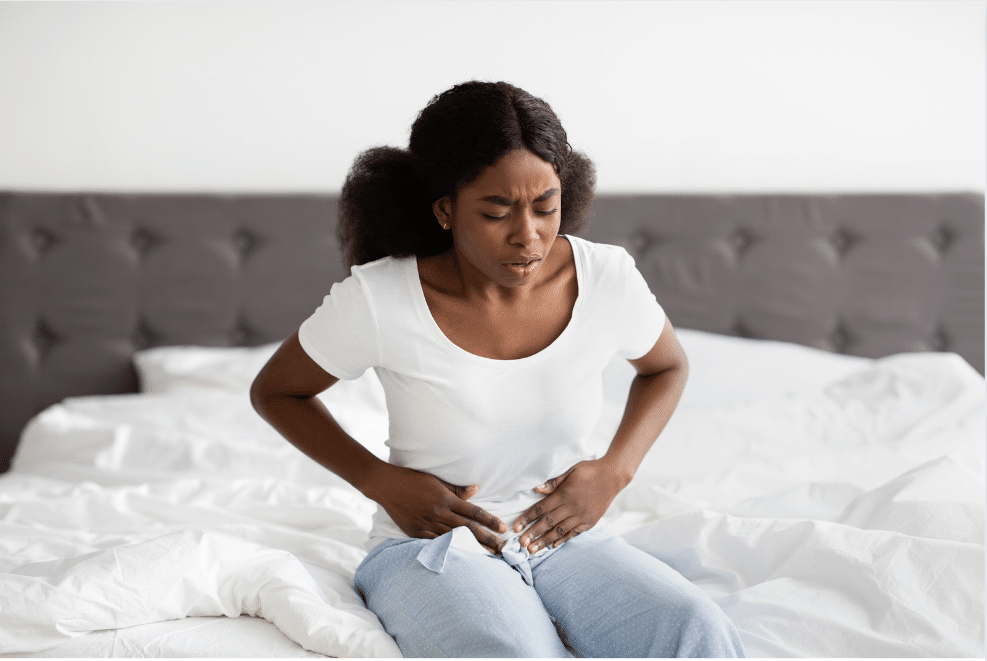
Light Periods
A light period is when you bleed for fewer than two days, or your bleeding resembles spotting. Very low or high body fat can cause you to have light periods, according to a 2008 study published in the Oxford Academic. Factors that affect our hormones, like stress, overexercising, hormonal birth control, age and breastfeeding can also cause light or irregular periods.
In some instances, a light period could indicate a hormone-related condition. See your doctor if your periods suddenly become lighter with no known cause, if you’ve missed three periods in a row, if you’re pregnant, if you’ve noticed other symptoms or if you’re concerned.
Irregular Periods
While you may have heard that a regular cycle is 28 days long, a 28-day cycle is quite rare. One 2019 study covered over 600,000 menstrual cycles and found that only 13% of menstrual cycles are precisely 28 days, and it’s equally rare for ovulation to occur on exactly day 14. However, your periods would be irregular if your cycle is outside the 21-35 day range.

Many factors can cause irregular periods. The National Health Service explains that common causes of irregular periods include:
- Puberty
- Menopause
- Early pregnancy
- Hormonal contraception
- extreme weight loss or weight gain
- excessive exercise
- Stress
- Medical conditions, like polycystic ovary syndrome (PCOS) or a problem with your thyroid
If your period is irregular, keep a calendar marking the first and last day of your periods and bring it with you to your next gynaecology appointment. Your doctor will evaluate your menstrual schedule and see if there is any need for further investigation.
Delayed Periods
A delayed period might mean pregnancy, but regular delayed periods could also indicate delayed ovulation. Factors like stress, vigorous exercise or lack of body fat can affect ovulation and a woman’s cycle length.
A study by researchers at the National Institute of Health and the University of Oxford affirmed that stress affects a woman’s menstrual cycle. Their study showed that stress may also reduce a woman’s chance of becoming pregnant and that finding safe ways to alleviate stress may help.
Exercising too much can cause missed menstrual periods or make your periods stop entirely. Vigorous exercise may impair ovarian function and affect a woman’s menstrual cycle, according to a 2017 study published by NCBI. If you haven’t worked out in a long time and suddenly start a vigorous fitness routine, you may experience delayed or halted periods.
The Southern California Reproductive Center explains that body fat plays a significant role in reproduction and a woman’s cycle. Women with a low BMI produce a reduced oestrogen, leading to an abnormal menstrual cycle.
At the beginning of puberty and when menopause starts, it’s common for women to experience delayed or irregular periods. Hormonal factors like the Pill or Polycystic Ovary Syndrome (PCOS) can also alter your hormonal balance and cause delayed periods. If your periods are consistently delayed, talk with your doctor to determine any underlying causes.
Keep the Doctor Updated
From your first period to your last, you’ll live through around 450 periods. Over the years, it’s crucial to track your cycle, including the days you menstruate, the amount of flow you have, any symptoms you experience and what days you experience them.
There are plenty of apps available that can help you track your cycle, or you can simply record them in your diary. When you visit the GP, make sure to bring your tracker with you. This information can help your doctor know what’s typical and atypical for you. If you notice a change in your period symptoms, contact your doctor, let them know, and ask whether they advise coming in for a visit.
Postpartum periods: what to expect
If you are pregnant or have recently delivered your baby, you may be wondering when to expect your period to return.

After giving birth, if you aren’t breastfeeding, your period will typically return about six to eight weeks later. If you breastfeed your baby, your period may not return until you stop breastfeeding. Prolactin, the hormone needed to produce breast milk, can suppress reproductive hormones and keep your menstrual cycle at bay.
If your period does return quickly after childbirth and you had a vaginal delivery, your doctor might suggest that you use sanitary pads, which are gentler on your body than tampons. Ask your doctor if you can return to using a tampon or menstrual cup at your six-week postpartum checkup.
After childbirth, your body adjusts back to a regular menstrual cycle. The first period after delivery might be different from your pre-pregnancy periods. You may experience some of the following differences:
- A heavier flow
- Small blood clots
- Irregular cycle lengths
- Increased cramping or pain
- Lighter cramping than previously
Make sure to talk about your returned period with your healthcare professional at your six-week postpartum check-up. Tell them about your period and any symptoms you experienced, whether they seem normal or abnormal to you.
Period symptoms to know
As you get closer to the first day of your period, your body will most likely start sending you signs that it’s coming. Period symptoms, or premenstrual syndrome (PMS), are very typical. In fact, according to a survey by Active Iron, 99% of women have experienced period symptoms and 97% experience them frequently.

The duration and severity of these symptoms vary from woman to woman, but here are the most prevalent symptoms:
Typical Period Symptoms Women Experience Frequently:
- Tiredness/fatigue – 49%
- Backache/pain – 39%
- Stomach cramps/pain – 64%
- Stomach bloating – 43%
- Sore breasts/breast tenderness – 35%
- Headaches – 27%
- Migraines – 13%
- Skin breakouts – 27%
- Mood changes – 44%
- Low iron levels – 12%
- Change in bowel movements – 27%
- Vomiting – 3%
- Fainting – 3%
- Change of appetite – 20%
Talk to your healthcare professional if your period is causing you to:
- Experience severe pain
- Feel depressed
- Miss work or school regularly
- Feel fatigued
- Have intense mood swings
- Struggle to participate in your usual daily activities or duties
Fatigue and your period
Ever wonder why you feel so tired during your period? After ovulation, oestrogen levels fall quickly, causing you to feel tired or sluggish. Oestrogen levels continue to fall during your period, causing your energy levels to dip further during your time of the month.

Inadequate iron levels resulting from menstrual blood loss can cause lower energy levels. 49% of women experience tiredness and fatigue, according to our survey of 2,400 women in the UK and Ireland. 18% of women experience tiredness and fatigue for more than seven days of their cycle.
Monthly periods are the most common cause of iron loss worldwide, and research shows that women of childbearing age need up to 2X more daily iron than men. Routine iron supplementation can help support energy levels and help reduce tiredness and fatigue.
Certain foods can also play a role in how energetic or lethargic you feel during your period. (See our section below on the foods to enjoy and avoid during your period). Poor-quality sleep or insomnia (a known symptom of PMS, according to a 2016 study published on the NCBI) could also be causing your fatigue. Researchers would recommend that women sleep between 7 and 9 hours each night, so prioritising a good night’s sleep may help to boost your mood and energy levels while on your period.
The London Women’s Centre found that light exercise can help boost women’s energy levels and moods while on their periods. Harvard Health Publishing notes that dehydration can also lead to fatigue, so increase your water intake throughout the week while you’re losing body fluid and blood to help support your energy levels.
Period bloating
As your period approaches, your body and its hormones are shifting. Research published in the NCBI suggests that this shift in progesterone and oestrogen levels causes the body to retain more water and salt. When the body’s cells become swollen with water, we feel bloated. 54% of women experience stomach bloating due to their menstrual cycle, with 43% experiencing it frequently.
Thankfully, you can take steps to reduce bloating during your period. Avoiding salty foods and refined carbohydrates and eating more potassium-rich foods can help with period bloating. Drinking plenty of water can decrease bloating. A 2013 study published in the NCBI found that eight weeks of regular exercise improved PMS symptoms, including bloating.

If bloating is causing you to struggle to carry out your usual daily activities or duties, or if bloating doesn’t go away after your period, it’s time to talk with your doctor. They can discuss your symptoms, possible conditions and solutions for these symptoms.
Back pain and your period
Back pain during your period is typically due to muscle contractions, but it’s also related to hormonal changes. 54% of women have experienced back pain during their period, with 39% experiencing it regularly. Prostaglandins (the hormones your body releases during menstruation to promote uterine contractions) can affect your back and cause it to feel sore, achy, and crampy. In 2016, a study published in the NCBI linked higher inflammation with worse PMS symptoms, including lower back pain.
Lower back pain is a typical PMS symptom. Johns Hopkins Medicine explains that severe lower back pain may be a symptom of Premenstrual Dysphoric Disorder (PMDD), dysmenorrhea or endometriosis. In addition to your other period symptoms, make sure you’re talking to your gynaecologist about any abnormal symptoms, including severe back pain, that you’ve experienced during recent periods.
Period mood swings
Mood swings leading up to and during your period are common. Our study of women throughout the UK and Ireland showed that 61% of women experience mood swings around their periods. Many women experience emotional symptoms of PMS, including mood swings, sadness, irritability, anxiety, and anger.
Hormonal changes can influence mood changes during the second half of the menstrual cycle. Oestrogen and progesterone both drop after ovulation. A shift in these hormones can lead to both physical and emotional symptoms.

If you notice that your mood swings negatively affect your relationships or feel out of control of your emotions, talk to your gynaecologist about PMDD. Women with PMDD have PMS symptoms in addition to severe anxiety, depression and mood changes. Your doctor can help you manage PMDD and PMS by tracking your symptoms, making lifestyle changes, using hormonal contraception or finding relief through an antidepressant.
In need of a new doctor to help with your period mood swings? The International Association for Premenstrual Disorders offers resources, online communities and assistance in finding a doctor familiar with PMS or PMDD.
Period cravings and what to do
Did you know that cocoa reduces inflammation, produces happy feelings and eases PMS symptoms? 21% of women change their eating habits to help themselves feel better during their period.
Our chocolate cravings can help us see that sometimes our bodies know what they need more than our minds do, so listen to your body’s cravings during your menstrual cycle.
On the other hand, some cravings can signify another issue going on. The rapid hormone changes can cause you to crave certain nutrients (like magnesium, found in dark chocolate).

What should you do if your cravings are for food? Don’t fight it. Many of your cravings are your body’s attempt to medicate and heal itself. For example, after a drop in serotonin common during PMS, your body might ask for a bowl of pasta—carbohydrates act as fuel to make more serotonin.
Healthy Foods That Can Ease Period Symptoms
If you’re concerned about unhealthy weight gain or are struggling with overeating during your period, try to satisfy your food cravings with healthy options. Focus on providing your body with iron, magnesium, and omega-3 fatty acids from whole foods, like the following:
- Eat sea vegetables, which contain high amounts of magnesium.
- If your menstrual flow is heavy, your iron levels can dip and cause fatigue, pain, and dizziness. Red meat, seafood, poultry, and leafy green vegetables can help boost your iron levels.
- Make yourself a comforting quinoa bowl to curb your carb cravings. Rich in iron, protein, and magnesium, quinoa is healthy for your body during your period.
- Like you saw above, there’s a reason why we crave chocolate during our periods. Try to stick with dark chocolate, which contains a much higher amount of cocoa and therefore flavanols and minerals.
- Omega-3 fatty acids found in foods like fish, nuts, and seeds can reduce inflammation, which can aid in decreasing menstrual cramps.
- Make sure to drink plenty of water, which can ease any bloating or dehydration headaches you might experience during your period.
- Sip on some ginger tea (ginger has anti-inflammatory effects), soothe achy muscles and reduce nausea).

Foods to Avoid During Your Period
It is essential to eat a healthy balanced diet; however, some foods can worsen the symptoms of your period. If you’re hoping to adjust your diet for an easier week, go light on the following six ingredients:
- Sugar: Sugar is an inflammatory and can increase cramping. According to Registered Nutritional Therapist & Certified Fertility Specialist, Julia Young, “When it comes to our sex hormones, a diet high in sugar is associated with altering the ratio of oestrogen and progesterone in the body, which can cause hormonal disturbances, mood swings, irritability, and insomnia.”
- Salt: Salty foods can also be avoided during your period since, according to Harvard Health Publishing, they can increase bloating and water retention in your body. If you want to avoid worsening your symptoms, cut back on food that is high in sodium a week or two before your period is due to start. Skip foods high in salt to alleviate some of the discomforts during your next period.
- Coffee: According to the National Institutes of Health, too much coffee can cause vasoconstriction—the constriction and narrowing of blood vessels. Vasoconstriction can cause the blood vessels in your uterus to tighten, restricting blood flow and oxygen to your uterus. Your uterine muscle needs oxygen to function correctly. Without a plentiful supply of it, you could experience more pain and cramping during your period. Try to stick to a maximum of one cup of coffee per day during your period if your goal is to lessen cramping.
- Alcohol: While it’s safe to drink alcohol responsibly during your period, the BMC Women’s Health journal explains that alcohol’s dehydrating effect on our bodies can worsen already painful period cramps. Thickened menstrual fluids and blood that results from dehydration are harder (and more painful) to pass. Try limiting your alcohol and boosting your water intake to help your period symptoms.
- Spicy food: Capsaicin—a powerful ingredient that makes foods like cayenne or chilli peppers spicy—can irritate the stomach lining or intestines. Spicy food can trigger stomach pain and diarrhoea if you have a more sensitive gut or have more spice than usual. You may want to skip the spicy food and its discomfort.
Exercise during your period
For most people, exercise can help support a healthy lifestyle. A 2015 study in the NCBI found that exercising can even aid in balancing and regulating hormones. But is it helpful to exercise during your period?
Hitting the gym might be the last thing on your mind during your period. In fact, in our study of women across the UK and Ireland, 44% of women stop physical exercise during their period.

Walking, light aerobic exercise, strength training, or gentle stretching and balance exercises are usually best during your period. Make sure to not push your body too hard in any activity, and stop if you’re experiencing increased pain or discomfort. Keep your workouts light and easy during your period, and only complete what makes you feel better.
Period underwear can offer comfortable protection of your clothes while you work out. If you prefer to go commando during workouts, many brands also offer period leggings and shorts.
During your workouts, make sure to stay hydrated, which will help ease unpleasant period symptoms like bloating and constipation. Keep a bottle of water with you at the gym and rehydrate at least every 15 minutes during your exercise session.
Over-the-counter pain relievers can also make workouts more comfortable. Alternatively, apply ice or a heating pad to your lower abdomen or lower back after your workout.
Exercise increases our heart rate and, therefore, our blood flow when we’re on our periods. While exercise can help blood exit the uterus faster, go to the gym prepared with extra protection on hand.


